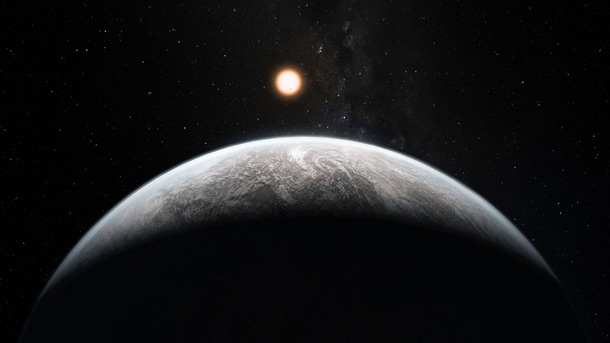Astronomers have announced a whole new passel of planets orbiting stars near the Sun: 50 more, the single largest group ever announced at one time*. It’s an indication of just how good we’re getting at finding these things. Even better: many of these planets are at the upper end of what we might call Earth-like.
 ESO artist drawing of an Earth-like planet orbiting a Sun-like star. Click to enplanetate. Credit: ESO/M. Kornmesser
ESO artist drawing of an Earth-like planet orbiting a Sun-like star. Click to enplanetate. Credit: ESO/M. Kornmesser
The instrument, called HARPS, for High Accuracy Radial velocity Planet Searcher, is a spectrograph. It takes light from distant objects and breaks it down into incredibly thin slices of wavelength, like a rainbow with a hundred thousand colors†. A planet orbiting a star tugs on the star with its gravity, pulling it toward and away from us over the course of its orbit. This makes an incredibly small shift in the colors of the star, but well within the capability of HARPS to detect.
The team used HARPS (PDF) to survey 376 stars like the Sun (similar mass, size, and temperature) and found that 40% of them have at least one planet with less mass than Saturn. 40%! That’s incredible! Just doing some very rough math, 10% of the stars in the Milky Way could easily be called Sun-like. If 40% of those host planets the size of Saturn or smaller, there are billions of planets that size in our galaxy alone.
That’s a whole lot of planets.
They also found that Neptune-mass planets appear to be common in multiple planet systems; in fact that’s apparently where the majority of them are. In other words, planets like Neptune are pretty easy to make, especially when there are other planets in the system.
 16 of the 50 planets discovered by HARPS in this release are so-called “super-Earths”, with masses a few times that of our home planet. Interestingly, you might expect them to have higher gravity than Earth since they’re more massive, but if they are also less dense – that is, bigger in size – then you might not weigh all that much more standing on the surface of one. For example, a planet with 5 times Earth’s mass but twice the radius would have a surface gravity only 20% higher than Earth; if you weighed 150 pounds here you’d weigh 180 pounds there.
16 of the 50 planets discovered by HARPS in this release are so-called “super-Earths”, with masses a few times that of our home planet. Interestingly, you might expect them to have higher gravity than Earth since they’re more massive, but if they are also less dense – that is, bigger in size – then you might not weigh all that much more standing on the surface of one. For example, a planet with 5 times Earth’s mass but twice the radius would have a surface gravity only 20% higher than Earth; if you weighed 150 pounds here you’d weigh 180 pounds there.
Unfortunately, HARPS can’t tell us the sizes of these planets, just their masses – the planet would need to transit its star for us to get that information. We also have no clue if these planets have atmospheres or, if they do, what they’re made of.
However, it can tell us how far these planets are from their stars, and given the temperatures of the stars involved, we can also state that two of these super-Earths (Gliese 851 d and HD 85512b (PDF)) are near or inside the zone around their parent stars where liquid water could conceivably exist on their surfaces. Again, we don’t know a whole lot about these planets just yet except their masses, but their location at the right distances from their stars is a good sign. It means there could be a whole lot of planets out there that look a whole lot like Earth.
And we’ll know better very soon. A new exoplanet-finding instrument is being built and will be operational in 2016. Called ESPRESSO – Echelle SPectrograph for Rocky Exoplanet and Stable Spectroscopic Observations – it’s an even more sensitive instrument than HARPS. It should be able to detect the planets with the same mass as Earth, well within their stars’ habitable zones. From another star, it could actually detect Earth orbiting the Sun!
My gut feeling – based on the numbers we’ve been seeing the past couple of years – is that there are a lot of stars out there hosting planets like Earth. My gut’s been wrong before… but we won’t have to wait very long to find out.
* Earlier in 2011, the Kepler mission announced 1200 planets, but those are candidates, and not yet confirmed.
† Seeing this data would no doubt make the double-rainbow guy’s head explode.
Related posts:
- Motherlode of potential planets found: more than 1200 alien worlds!
- How many habitable planets are there in the galaxy?
- Nearby “Earth-like” planet: not so much
- Dense exoplanet gets the lead out and in
- Kepler finds a mini solar system